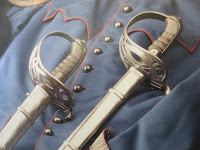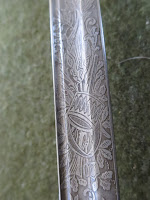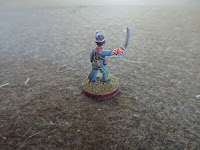Closeup of the officer's standard version of the Austrian M1861 Cavalry Saber (note the engraved lines around the piercings on the guard).
Image from: Ortner, With Drawn Sword: Austro Hungarian Edged Weapons from 1848 to 1918; text in the author's collection.
Greetings, dear reader(s). This post is a continuation of the Sword Lore III post on the Austrian M1861 Cavalry Saber (service version). I have both an officer's and a service version of that sword, and I had originally intended to cover both in that post (as per the post on the Prussian M1852 Cavalry Saber). However, the previous post turned out to be rather lengthy, and so I decided to produce a separate post on the officer's version. Thus, in this post, I won't repeat the history and details of the development of the M1861 saber: I would encourage anyone interested to follow the link above to that post. This study will focus on the general trends and context of officer's pattern swords, and then examine the actual sword in my collection. As usual, you may clix pix for BIG PIX in this post.
A BIT OF CONTEXT AND BACKGROUND
Two volunteer Austrian hussar officers, circa 1866, sporting rather slim private purchase officer's sabers.
When it comes to non-service swords (ie, that are not army property issued to soldiers), the term "private purchase" is technically more correct than "officer's sword." Generally speaking, all officers in most armies did purchase their own swords (in addition to uniforms and other equipment). However, noncommissioned officers (in particular) and soldiers with other forms of status could do so as well. For simplicity, though, we'll refer to these as "officer's swords" in this post. Although officer's swords could exhibit many variations based on the maker, and the preferences, means, and status of the purchaser, they nevertheless were still required to conform to a basic regulation pattern for the army concerned (of course, the higher the rank and status of the officer, the broader the departures from the standard could be).
Austrian enlisted dragoon trooper, circa 1866, posing with the beefy M1861 issue cavalry saber.
Given these parameters, there are several points that hold true for most officer's cavalry sabers. The first and most persistent is that they are almost always lighter than their regulation counterparts. Compare the dragoon's sword (above) to the slimmer ones carried by the volunteer officer hussars in the opening picture (both the Austrian dragoons and hussars carried the same pattern M1861 sword). Officer's sabers are also quite often embellished (particularly their blades), and would be more likely to be nickel plated--a customization that was not only more attractive but protective, making for lower maintenance. Officer's swords don't have the ordnance stamps and other standard markings of government service swords, making them more difficult to identify and date. Speaking of collecting, officer's swords are generally more available than issue swords given that they remained with the individual after service (years later becoming the proverbial sword in the attic that one stumbles across when clearing out a house). Finally, there is the question of whether these were "dress" swords or combat weapons. The answer is "both." There are no doubt some that were only worn about town, on parade, or in garrison as part of the uniform. But there were no doubt some that were also combat weapons: and there were some that would serve as both. Although the materials and construction could certainly be an indicator of whether a sword would be suitable to carry into action, without knowing the specific provenance of a weapon, it could be hard to tell. Enough of generalities. On to the specifics of the M1861 officer's sword and the actual sword in my collection
THE M1861 CAVARLY SABER OFFICER'S PATTERN
Above left: issue saber and officer's "standard" M1861 saber. Above right: private purchase non-standard officer's saber.
MY M1861 OFFICER'S SWORD
As I have mentioned, I have both an issue and an officer's M1861 Cavalry Saber.
SIDE BY SIDE
In comparison, you can see that this officer's sword (the lower one) is a lighter version of the issue (service version) M1861.
THE HILT
The hilt of my officer's sword has the regulation engravings around the piercings (and more). Side by side, nickel plating aside, you can see other minor variations in this particular officer's hilt. This is not a "standard" officer's version. Although we will be delving into the officer's blade separately, this picture illustrates one of the major departures between them. The service sword has the distinctive asymmetrical blade profile, with one side flat and the other fullered (shown by the yellow arrow). The officer's version has a conventional symmetrical blade profile, with both sides fullered.
Comparison of the grips. Above left: the officer's version, left, and the service version, right. Above right picture, a detail of the officer's version grip. As is often the case with officer's swords, the grips are of shark or fish skin (as this one is), and they almost always have fine, woven wire wraps.
THE BLADE
As opposed to the heavy, asymmetrical blade of the service sword, this officer's sword has a slimmer blade with a stiff spine and a hybrid diamond shaped profile (meaning that it has a raised ridge running it's length). Additionally, the central third of the blade has two fullers: a narrow fuller just under the spine and a conventional larger fuller centered in the upper 1/2 of the blade. This larger fuller lightens and balances the blade, and the smaller (ridge) fuller provides structural strength, also making the blade stiffer--to compensate for its slimness (my conjecture). In terms of handling, this is a very nimble weapon. I am not a practitioner of historical european martial arts, but I have dabbled in fencing years ago. This weapon would handle not unlike a contemporary fencing saber.
As with most officer's swords, this blade is decorated. In this case, it is engraved (as opposed to etched like my 1852 Prussian Officer's sword), with ornaments running along 2/3 of the blade.
Detail of the blade ornaments: in the upper right and lower left images you can see the blade profile more clearly, with the two fullers and the central ridge.
DECODING (READING) THE SWORD
So far, we've seen that this sword conforms to what we would expect for an Austrian M1861 Officer's Cavalry Saber. Besides these general points, though, how do we "read" this sword, and what story does it tell? (Hint: stick around for a "surprise" ending).
Unlike service swords, officer's swords lack standardized markings to help us with authentication. Generally speaking, most will at least have a manufacturer's stamp, usually on the ricasso (the base of the blade next to the hilt). Fortunately, we have such a stamp on this sword: "F.H."
"Friedrich Horster Jr, of Solingen, Germany, 1825-1875. They had an office in London and also sold weapons to the North during the U.S. Civil War."
(Kinman, Steffan, European Makers of Edged Weapons, page 37).
In the 19th Century, many (if not most) of the swords in Europe were produced by Solingen sword makers. And if the sword was manufactured elsewhere, the chances were that the blade used was made in Solingen. As a matter of fact...
...this tradition in blade making continues to this day, with fine cutlery being produced in Solingen. Much like Krupp, who sold weapons to everyone (basically), nations at that time would contract with various Solingen manufacturers for their swords. And, of course, there was a parallel market for individual, private purchases.
THE STORY OF THE SCABBARD
Looking at the scabbard tells us more. The Austrian M1861 service sword's scabbard (above left) exhibits a major design change that came into Austrian use with it. Specifically, they dropped the two flexible scabbard ring configuration and replaced it with a fixed (lower) scabbard ring and upper fixed bracket (if you look closely at the dragoon picture at the top of this post, you can see that his scabbard is configured like this). This configuration was unique to the Austrian army from that point onwards. Looking at the scabbard on this officer's sword (above right), you can see that it is a "universal" pattern that could fit any configuration. It has two flexible scabbard rings and a fixed upper bracket. Thus, a buyer could easily modify this scabbard to fit whatever regulations applied. For instance, as the century progressed, armies were discarding lower scabbard rings. If that were the case, the buyer could simply cut off the lower ring. If in Austrian service, he could cut off the upper ring and use the fixed bracket and remaining lower scabbard ring. WHAT WE CAN SAY ABOUT THIS SWORD?
Because know...
1) that the sword conforms to the Austrian M1861 pattern
2) that the pattern was first introduced in 1861 (per its name).
3) that the manufacturer was in business from 1825-1871.
We can conclude...
...that this sword dates from 1861 to 1867.
WHAT CAN WE GUESS ABOUT USE?
We know...
1) that the blade has not been service sharpened.
2) that the quality of the blade is exceptional and it could be sharpened.
3) that the blade is configured for added strength and is well balanced.
4) that the blade is ornamented/ornamental.
5) that the guard is as sturdy as the service version and would provide equal protection.
We can neither conclude or rule out...
...that this sword model was intended for--or could be used--in action.
We can conclude...
...that this particular sword was not actually carried in combat given that it was not service sharpened.
THE SURPRISE ENDING
The Arms of Savoy
Although this is clearly an Austrian M1861 pattern officer's sword, it is marked with the arms of Savoy (on the hilt, above, and on the blade, below). The dating of this sword puts it in the timeframe of the Risorgimento, during which the house of Savoy (Piedmont-Sardinia) was aligned against Austria. Thus, this sword was most likely not used by an Austrian, but was most likely purchased by an officer in Italian service--and it could very well have been a standard model designed for sale to officers in that market.
















































